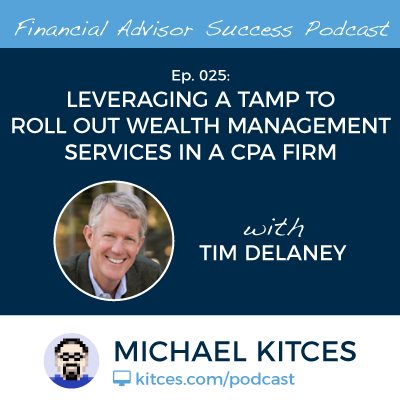 Welcome back to the twenty-fifth episode of the Financial Advisor Success podcast!
Welcome back to the twenty-fifth episode of the Financial Advisor Success podcast!
My guest for this week’s podcast is Tim Delaney. Tim is the co-founder of JDH Wealth Management, an independent RIA in northern California that oversees nearly $200 million of assets for 120 affluent clients.
What’s unique about Tim is that, unlike most financial advisors who started out selling life insurance or mutual funds, Tim began his career as a CPA, and it wasn't until after 20 years of experience doing accounting and tax preparation that he decided for the first time to launch a wealth management firm, from within the existing accounting business, with a goal of leveraging the firm's existing relationships with its tax clients to expand into wealth management.
In this episode, Tim talks about the transition from tax preparation into wealth management, why he decided from day 1 to build his wealth management business on a TAMP platform - despite the fact that it would take a material chunk of his long-term revenue - how he structured the wealth management firm as a separate entity from the tax practice, and why he ultimately decided to buy out the wealth management division and part ways from the accounting firm after more than a decade... which, as it turned out, just accelerated the growth of his wealth management firm even further!
We also talk at length about the opportunity that CPAs have in offering wealth management services to clients, how the typical accounting firm can likely generate an additional 25% of gross revenue by offering investment management services to existing clients, and why most accounting firms still fail to capitalize on the business opportunity. Which provides some interesting insights into the opportunity – and challenges – for financial advisors seeking to generate wealth management referrals from CPAs, too.
And be certain to listen to the end, where Tim talks about how he's executing an internal succession plan, with his son who has now taken over as the managing partner, and how he structured the arrangement not to gift shares but to have his son buy into the practice over time... in large part because that's what was necessary to balance the value of the business against what his other two children, who aren't involved in the business, will also someday inherit.
So whether you’re a CPA considering whether to go into wealth management, an advisor trying to better understand the mindset of CPAs who offer (or may be considering) wealth management services, or are looking for perspective on why a TAMP can make a lot of sense when launching a planning-centric advisory firm, I hope you enjoy this latest episode of the Financial Advisor Success podcast!

 Welcome back to the twenty-fourth episode of the Financial Advisor Success podcast!
Welcome back to the twenty-fourth episode of the Financial Advisor Success podcast!
